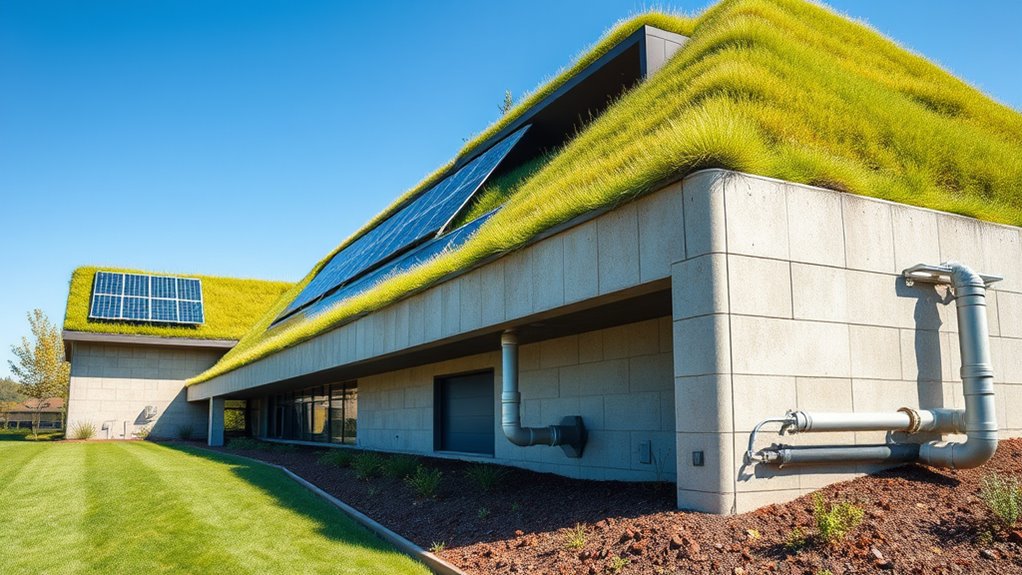Geothermal heat pumps are an efficient way to power a net-zero building, using underground temperature stability to heat and cool your space. They transfer heat between your building and a ground loop filled with fluid, reducing energy use and lowering costs. Integrating these systems with smart controls and passive design elements boosts performance and sustainability. Explore further to discover how innovations are shaping the future of geothermal technology and net-zero strategies.
Key Takeaways
- Geothermal heat pumps utilize the earth’s stable temperature for efficient heating and cooling, supporting net-zero energy goals.
- Integrating geothermal systems with passive design and smart controls enhances overall building energy performance.
- Proper installation and maintenance ensure long-term efficiency, reducing operational costs and aiding in achieving net-zero targets.
- Geothermal’s renewable nature lowers greenhouse gas emissions, aligning with sustainable building and net-zero strategies.
- Advances in drilling, materials, and data analytics are improving geothermal integration, making net-zero buildings more feasible and cost-effective.
Understanding How Geothermal Heat Pumps Function
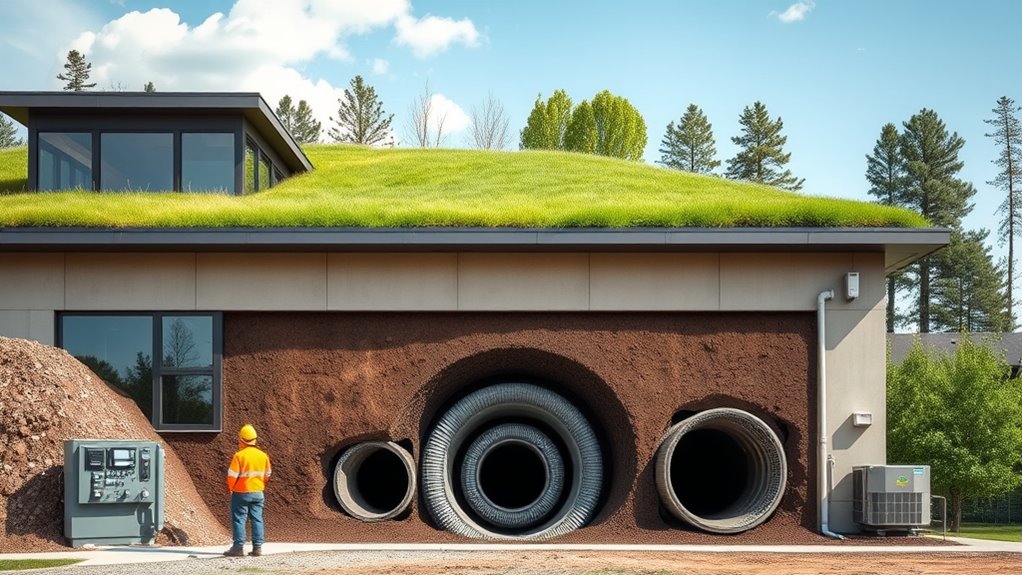
Geothermal heat pumps work by transferring heat between your building and the stable ground below. When you need to heat your space, the system uses a ground loop filled with a fluid to absorb heat from the earth. The heat transfer occurs as the fluid circulates through the loop, carrying thermal energy to the heat pump. During cooling, the process reverses: heat is extracted from your building and transferred into the ground via the loop. The ground’s consistent temperature makes this process highly efficient, reducing energy consumption. The ground loop acts as a thermal reservoir, facilitating continuous heat exchange without depleting or overheating the earth. This closed-loop system guarantees reliable, low-maintenance operation while maximizing energy efficiency in your building’s climate control. Regular maintenance and proper installation are essential to ensure optimal performance and longevity of the system, especially given the ground loop’s role in efficient energy transfer. Additionally, understanding the ground temperature helps optimize system design for different climates. Properly managing the system’s components can further enhance energy savings and operational durability. Furthermore, selecting the right installation method impacts overall system efficiency and lifespan.
Integrating Geothermal Systems Into Sustainable Building Designs
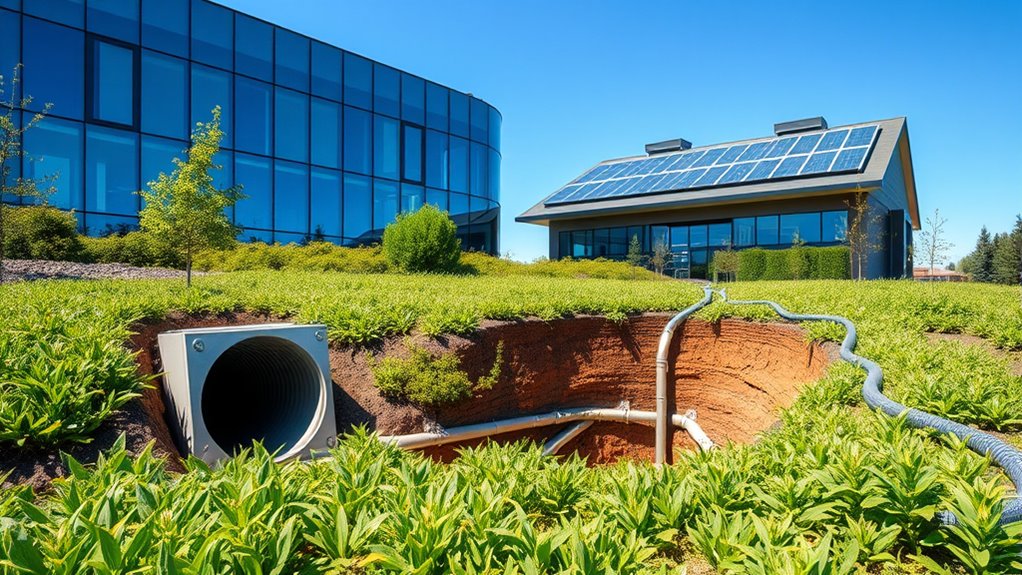
Integrating geothermal systems into sustainable building designs offers a practical way to considerably reduce energy consumption and lower carbon emissions. To maximize geothermal efficiency, you need seamless system integration that complements your building’s architecture and energy needs. Proper integration ensures the geothermal heat pump works efficiently alongside other renewable systems, enhancing overall performance. Take into account the following:
- Coordinating system placement with building layout for ideal heat transfer
- Using smart controls to enhance system responsiveness and efficiency
- Incorporating insulation and passive design elements to reduce load
- Considering sound design principles to minimize operational noise and improve comfort within the building environment
- Ensuring system compatibility with existing building features can further optimize performance and sustainability. Additionally, understanding vetted products and solutions can help select reliable components that meet safety and efficiency standards. Exploring top-rated options in geothermal heat pumps can also boost system reliability and lifespan. Incorporating renewable energy integration techniques can further enhance the overall sustainability of the building, making geothermal systems a key part of net-zero strategies.
Environmental and Economic Benefits of Geothermal Heat Pumps
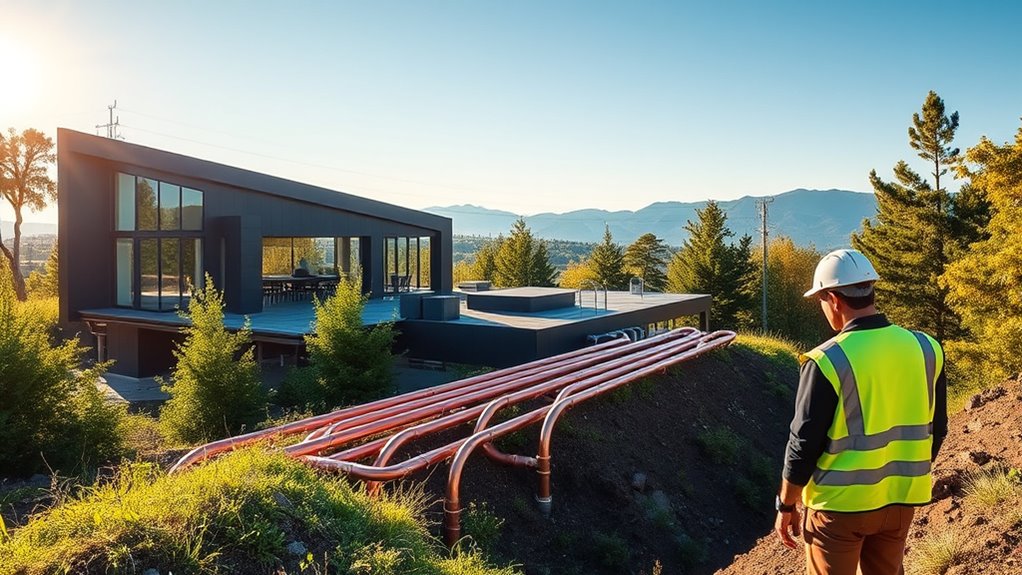
By harnessing the Earth’s stable underground temperatures, geothermal heat pumps deliver significant environmental and economic advantages. You’ll notice substantial cost savings over time due to their energy efficiency, reducing your utility bills. Additionally, these systems lower environmental impact by decreasing greenhouse gas emissions compared to conventional heating and cooling methods. Here’s a quick overview:
| Benefit | Description | Impact |
|---|---|---|
| Cost Savings | Reduced energy consumption lowers expenses | Long-term financial gains |
| Environmental Impact | Less reliance on fossil fuels decreases emissions | Cleaner, greener footprint |
| Energy Efficiency | High efficiency in heating and cooling processes | Lower operational costs |
These benefits make geothermal heat pumps an excellent choice for sustainable, cost-effective building design. Incorporating energy-efficient technologies like geothermal systems can further enhance overall building performance, especially when paired with other renewable energy sources. Implementing sustainable building practices can maximize the benefits of these eco-friendly systems and contribute to achieving net-zero energy goals. Integrating innovative solutions in system design can optimize geothermal performance and expand their application across different building types. Moreover, understanding the role of creative practice in designing innovative solutions can inspire new ways to optimize geothermal systems within sustainable development.
Challenges and Considerations in Implementing Net-Zero Strategies
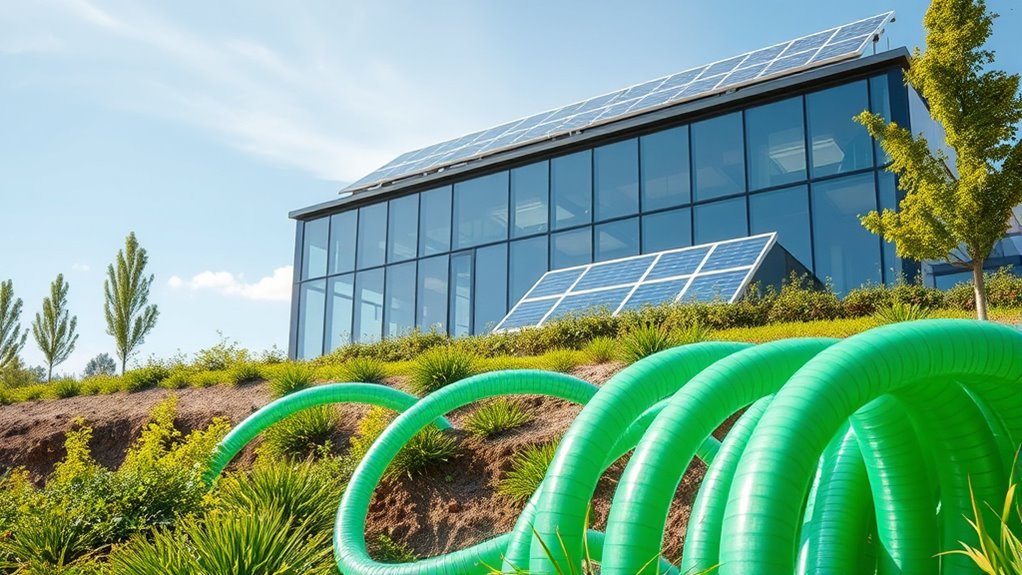
What are the main hurdles when implementing net-zero strategies in building projects? Policy hurdles often slow progress, with regulations sometimes lagging behind technology or lacking incentives. You might also face high upfront costs that deter investment, even if long-term savings are clear. Maintenance challenges can arise because geothermal systems require ongoing care to guarantee efficiency, which some overlook during planning. Additionally, integrating renewable energy sources with existing infrastructure can be complex. Vendor reliability is crucial to ensure consistent support and system performance.
Future Trends and Innovations in Geothermal Technology

Advancements in geothermal technology are paving the way for more efficient and cost-effective solutions, shaping the future of sustainable building design. Enhanced drilling techniques allow for deeper and more precise access to geothermal reservoirs, reducing installation time and costs. Innovations in advanced materials, such as high-performance insulation and corrosion-resistant piping, improve system durability and efficiency. These developments enable geothermal systems to operate reliably in diverse geological conditions. Future trends include the integration of smart controls and data analytics, optimizing energy use in real-time. Additionally, hybrid systems combining geothermal with other renewable sources will become more common. As these technologies evolve, you’ll find geothermal becoming an increasingly viable, sustainable option for achieving net-zero buildings with lower upfront costs and longer-term savings. Predictive analytics can further enhance system performance by forecasting energy demand and adjusting operations proactively.
Frequently Asked Questions
What Are the Typical Installation Costs for Geothermal Heat Pumps?
You might wonder about the initial installation costs of geothermal heat pumps. Typically, it ranges from $10,000 to $30,000, depending on property size and system complexity. While the upfront expense can seem high, you’ll benefit from long-term savings through lower energy bills and reduced maintenance costs. The initial investment is offset over time, making geothermal systems a cost-effective and eco-friendly choice for sustainable heating and cooling.
How Long Do Geothermal Systems Usually Last Before Needing Replacement?
Did you know geothermal systems often last over 25 years? Generally, their system lifespan exceeds 20-25 years, making them a durable choice. You might expect a replacement timeline around that period, but with proper maintenance, some systems can last even longer. You’ll want to monitor performance and schedule inspections to extend your system’s lifespan, ensuring you get the most value before considering replacement.
Are There Specific Building Types Best Suited for Geothermal Heat Pumps?
You might wonder if certain building types are better suited for geothermal heat pumps. Generally, residential buildings with moderate space and energy needs work well, thanks to their manageable size and consistent usage. Commercial facilities, especially those with large heating and cooling demands, can also benefit, but they require more extensive system design. Overall, geothermal systems suit a range of building types, but site specifics and energy requirements influence their suitability.
What Maintenance Is Required to Ensure System Efficiency Over Time?
To keep your system running efficiently, you need to perform regular maintenance. This includes changing the system filter regularly to prevent dust buildup, inspecting the underground loops for leaks or damage, and flushing the system to remove debris. By staying proactive with system filter replacement, underground loop inspection, and system checks, you guarantee peak performance and longevity, preventing costly repairs and maintaining energy efficiency over time.
How Do Geothermal Systems Perform in Extreme Climate Conditions?
You might wonder how geothermal systems handle extreme climate conditions. These systems are designed for climate adaptation, maintaining efficiency even in very hot or cold weather. Their system resilience guarantees reliable performance by leveraging stable underground temperatures. You’ll find that with proper installation and maintenance, geothermal systems continue to operate effectively, providing consistent heating and cooling, regardless of outside climate extremes.
Conclusion
Just as Icarus aimed for the sun’s heights, embracing geothermal heat pumps can elevate your building’s sustainability. By understanding their function and integrating them thoughtfully, you harness nature’s energy wisely. While challenges exist, innovation and commitment will guide you toward a net-zero future. Remember, like Daedalus’s wings, these systems are your craft—requiring care and foresight to achieve harmony with the environment and soar above conventional limits.
